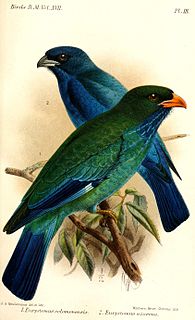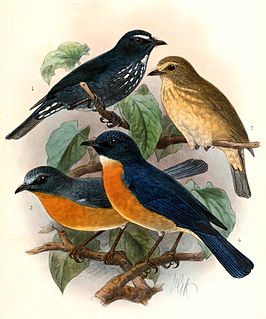
Buteo is a genus of medium to fairly large, wide-ranging raptors with a robust body and broad wings. In the Old World, members of this genus are called "buzzards", but "hawk" is used in North America. As both terms are ambiguous, buteo is sometimes used instead, for example, by the Peregrine Fund.

The akalats are medium-sized insectivorous birds in the genus Sheppardia. They were formerly placed in the thrush family, Turdidae, but are more often now treated as part of the Old World flycatcher family, Muscicapidae.

Accipiter is a genus of birds of prey in the family Accipitridae. With 51 recognized species it is the most diverse genus in its family. Most species are called goshawks or sparrowhawks, although almost all New World species are simply known as hawks. They can be anatomically distinguished from their relatives by the lack of a procoracoid foramen. Two small and aberrant species usually placed here do possess a large procoracoid foramen and are also distinct as regards DNA sequence. They may warrant separation in the old genus Hieraspiza.
The Rubeho akalat is a member of the Old World flycatcher family, (Muscicapiidae), known from the Eastern Arc of Tanzania. Akalats trapped in 1989 here were assumed to be an isolated population of Iringa akalat which occurs c. 150 km to the south, but further specimens collected in 2000 led to the description of the bird as a new species. The bird's English name relates to its type locality, Rubeho Mountains, Morogoro; the scientific name to the ochraceous colour on its throat and upper breast.

The ring-necked francolin is a bird species in the family Phasianidae. It is found in Burundi, Cameroon, Kenya, Rwanda, Tanzania, and Uganda. Rarer than previously believed, it is uplisted from a species of Least Concern to Near Threatened status in the 2007 IUCN Red List.
The least pauraque, or least poorwill, is a species of nightjar in the family Caprimulgidae of birds, and the only confirmed extant species of the genus Siphonorhis. It is endemic to the island of Hispaniola.

The chestnut-banded plover is a species of bird in the family Charadriidae. This species has a large range, being distributed across Southern Africa. However, it occupies a rather small area.
The Tawitawi brown dove is a threatened species of bird in the family Columbidae. It is endemic to forests in the Sulu Archipelago in the Philippines. Until recently it was considered conspecific with the Mindanao brown dove and collectively called the dark-eared brown dove. Although threatened by habitat loss, the rate of loss significantly reduced from 2004–2007, and it was thus downlisted from Critically Endangered to Endangered status in the 2007 IUCN Red List.

The azure dollarbird also known as the azure roller, purple dollarbird or purple roller, is a species of bird in the family Coraciidae. It is endemic to the Maluku Islands in Indonesia. Formerly, some authorities considered the azure dollarbird to be a subspecies of the oriental dollarbird.
The rusty-bellied shortwing is a species of bird in the family Muscicapidae. It is found in Yunnan, Northeast India and far northern Myanmar.

The long-tailed cinclodes is a species of bird in the family Furnariidae. It is endemic to Brazil.

The grey-winged robin-chat or grey-winged akalat is a bird in the family Muscicapidae. The species was first described by Anton Reichenow in 1892.

The Damar flycatcher is a species of bird in the family Muscicapidae. It is endemic to Indonesia.

The equatorial akalat is a species of bird in the family Muscicapidae. Its natural habitat is subtropical or tropical moist montane forests.
Bocage's akalat is a species of bird in the family Muscicapidae. It is found in Angola, Cameroon, Democratic Republic of the Congo, Equatorial Guinea, Nigeria, Tanzania, and Zambia. Its natural habitats are boreal forests, subtropical or tropical dry forests, subtropical or tropical swamps, and subtropical or tropical moist montane forests.

The lowland akalat is a species of bird in the family Muscicapidae. It is found in Cameroon, Central African Republic, Republic of the Congo, Democratic Republic of the Congo, Ivory Coast, Equatorial Guinea, Gabon, Guinea, Liberia, Nigeria, Sierra Leone, Tanzania, and Uganda. Its natural habitats are subtropical or tropical dry forest and subtropical or tropical moist lowland forest.
The Gabela akalat is a species of bird in the family Muscicapidae. It is endemic to Angola. The name is in part derived from the town where they were first observed, Gabela.
The Iringa akalat is a species of bird in the family Muscicapidae. It is endemic to Tanzania.
The Usambara akalat, also known as the Usambara alethe or Usambara robin-chat, is a species of bird in the family Muscicapidae. It is endemic to Tanzania.

Sharpe's akalat is a species of bird in the family Muscicapidae. It is found in Tanzania and northern parts of Zambia and Malawi. Its natural habitats are boreal forests and subtropical or tropical moist montane forests.












